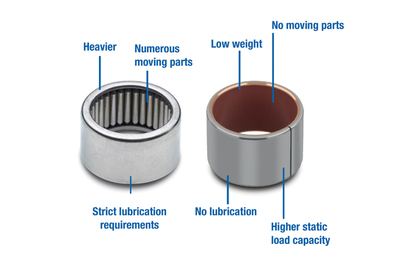
Contact Details:
GGB North America
700 Mid Atlantic Parkway
Thorofare
NJ
08086
United States of America
Tel: +1 856 686-2642
Fax: +1 856 848-5115
Send Enquiry | Company Information

Plain Bearings Offer Performance, Economic Advantages Over Rolling-Element Bearings
Product News Thursday, December 7, 2017: GGB North America
Plain bearings are replacing rolling-element bearings in a wide range of products including pumps, wind turbines, and equipment for agriculture and construction. Once it was thought that complex parts required complex rolling-element bearings, but designers are learning that plain bearings’ design simplicity has its advantages.
For many applications, replacing traditional roller bearings with today’s advanced plain bearings gives users both a technological and competitive edge. Leading the replacement trend are former needle-bearing users, who say plain bearings more easily accommodate small dimensional changes in housings and shafts. Users of larger ball and roller bearings are also realizing considerable savings from plain bearings.
More Favorable Economics Factors that attract designers to plain bearings are cost and weight. Roller bearings’ complex, multi-component design and precision construction can make them 25% to 400% more expensive than plain bearings. The tooling needed to install precision rolling-element bearings is another substantial cost; plain bearings’ tooling costs 50 to 75% less.
In some industries, like automotive and aerospace, designers can attach monetary value to weight savings, too. Automakers have been particularly aggressive in trimming weight to meet fuel-efficiency goals. A typical plain bearing weighs less than half that of a similar-sized, drawn-cup needle-roller bearing. Weight savings might not seem significant when individual bearings weigh 10 to 140 g, but they add up as bearings grow in size and number. Moving to single-part plain bearings also gets rid of snap rings, machined shoulders, and other rolling-element retention devices, all of which contribute to bearing weight.
Larger Contact Area Because plain bearings have a much larger surface-contact area than roller bearings, designers can save space and cost by using smaller plain bearings that accommodate greater loads
The conformability of their materials also lets plain bearings tolerate more shaft misalignment. Misalignment can increase wear and shorten life of roller bearings as the load is concentrated on a narrow contact area. By design, plain bearings, even when slightly misaligned, do not concentrate loads on balls or rollers but distribute them more evenly.
In addition, roller bearings may not perform particularly well under certain oscillating conditions. Low-amplitude, high-frequency oscillations can damage rolling-element bearings by concentrating the contact stress on a few bearing elements and their respective raceways, leading to fatigue failure and seal wear.
If the oscillation angle is small, the rolling elements won’t overlap and the contact zone can become lubrication-starved.
Plain bearings, on the other hand, distribute cyclical loads over a much larger area, sliding directly against the shaft and substantially reducing contact stresses and the risk of fatigue. Moreover, there are no rolling elements to inhibit the flow of lubricant and exacerbate its churning.
Less Vibration and Noise Unlike roller bearings, plain bearings have no internal moving parts, so there is nothing to rattle around. The layered structure and the materials themselves serve to absorb vibrations. The result is less noise from bearing and shaft interaction.
The one-piece structure also simplifies bearing installation and maintenance. Simply press it into the housing and you’re done. With rolling-element bearings, improper handling and assembly are leading causes of damage and early failure.
When properly designed and installed, any bearing should deliver the desired performance throughout the life of the application. Users can keep premature failures at bay by selecting the correct bearing for the operating conditions and performing appropriate and timely maintenance.
Yet, when properly applied, plain bearings save weight and space, carry more load, need less maintenance, and damp vibration better than their rolling-element counterparts.
